|
|
|
Sort Order |
|
|
|
Items / Page
|
|
|
|
|
|
|
| Srl | Item |
| 1 |
ID:
132781
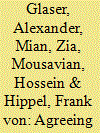

|
|
|
|
|
| Publication |
2014.
|
| Summary/Abstract |
Iran is negotiating with a group of six states over the future of its nuclear program. In November 2013, Iran and the P5+1 (China, France, Germany, Russia, the United Kingdom, and the United States) agreed to a Joint Plan of Action that seeks to reach a "comprehensive solution" by July 20, 2014.
The goal is an agreement on a set of measures that can provide reasonable assurance that Iran's nuclear program will be used only for peaceful purposes and enable the lifting of international sanctions imposed on Iran over the past decade because of proliferation concerns.
A key challenge is to reach agreement on limiting Iran's uranium-enrichment program, which is based on gas centrifuges, in a way that would enable Iran to meet what it sees as its future needs for low-enriched uranium (LEU) fuel for nuclear research and power reactors while forestalling the possibility that this program could be adapted to quickly produce highly enriched uranium at levels and in amounts suitable for use in nuclear weapons
|
|
|
|
|
|
|
|
|
|
|
|
|
|
|
|
| 2 |
ID:
142389


|
|
|
|
|
| Summary/Abstract |
The July 14 agreement between Iran and the six-country group known as the P5+1 established a set of important limitations and related transparency measures on Iran’s nuclear activities.
|
|
|
|
|
|
|
|
|
|
|
|
|
|
|
|
| 3 |
ID:
092920
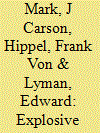

|
|
|
|
|
| Publication |
2009.
|
| Summary/Abstract |
The following discussion focuses on the question of whether a terrorist organization or a threshold state could make use of plutonium recovered from light-water-reactor fuel to construct a nuclear explosive device having a significantly damaging yield. Questions persist in some nonproliferation policy circles as to whether a bomb could be made from reactor-grade plutonium of high burn-up, and if so, whether the task would be too difficult for a threshold state or terrorist group to consider. Although the information relevant to these questions is in the public domain, and has been for a considerable time, it is assembled here for use by policy makers and members of the public who are concerned about preventing the spread of nuclear explosives.
|
|
|
|
|
|
|
|
|
|
|
|
|
|
|
|
| 4 |
ID:
150308
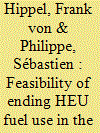

|
|
|
|
|
| Summary/Abstract |
Since September 11, 2001, the U.S. government has sought to remove weapons-useable highly enriched uranium (HEU) containing 20 percent or more uranium-235 from as many locations as possible because of concerns about the possibility of nuclear terrorism.
|
|
|
|
|
|
|
|
|
|
|
|
|
|
|
|
| 5 |
ID:
121714


|
|
|
|
|
| Publication |
2013.
|
| Summary/Abstract |
In 2000 the United States and Russia signed a Plutonium Management and Disposition Agreement (PMDA),[1] in which each side agreed to dispose of at least 34 tons[2] of weapons plutonium made surplus by the reductions in its Cold War nuclear arsenal. President Barack Obama has described the combined 68 tons of plutonium as enough "for about 17,000 nuclear weapons."
|
|
|
|
|
|
|
|
|
|
|
|
|
|
|
|
| 6 |
ID:
066986
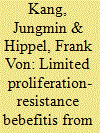

|
|
|
| 7 |
ID:
092918
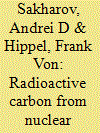

|
|
|
|
|
| Publication |
2009.
|
| Summary/Abstract |
In this article, which appeared in the June 1958 issue of the Soviet journal, Atomic Energy, Sakharov estimated that about 10,000 people would ultimately suffer cancers, genetic disorders, and other ill effects from the radioactivity produced by a 1-megation nuclear explosion in the atmosphere.
|
|
|
|
|
|
|
|
|
|
|
|
|
|
|
|
| 8 |
ID:
002192
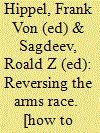

|
|
|
|
|
| Publication |
New York, Gordon and Breach Science Publishers, 1990.
|
| Description |
xi, 432p.
|
| Series |
Science and global security monograph series; vol.1
|
| Standard Number |
288124436X
|
|
|
|
|
|
|
|
|
|
|
|
Copies: C:1/I:0,R:0,Q:0
Circulation
| Accession# | Call# | Current Location | Status | Policy | Location |
| 033707 | 355.03/HIP 033707 | Main | On Shelf | General | |
|
|
|
|
| 9 |
ID:
024858
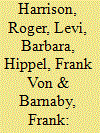

|
|
|
|
|
| Publication |
Warwickshire, Berg Publishers, 1986.
|
| Description |
ix, 214p.
|
| Standard Number |
0907582753
|
|
|
|
|
|
|
|
|
|
|
|
Copies: C:1/I:0,R:0,Q:0
Circulation
| Accession# | Call# | Current Location | Status | Policy | Location |
| 027346 | 355,825119/HAR 027346 | Main | On Shelf | General | |
|
|
|
|
| 10 |
ID:
130326
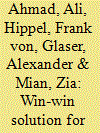

|
|
|
|
|
| Publication |
2014.
|
| Summary/Abstract |
In November 2013, Iran and the P5+1 group of countries (China, France, Germany, Russia, the United Kingdom, and the United States) agreed on a six-month Joint Plan of Action to enable negotiations on a final settlement to contain the proliferation risks from Iran's nuclear program. This interim agreement freezes Iran's enrichment capacity, thereby preventing a further shortening of the time Iran would require to produce weapons quantities of highly enriched uranium (HEU) if it wished.1 This enrichment capacity has expanded greatly over the years since it first came to international attention in 2002. Iran and the P5+1 also have agreed on the need to constrain Iran's option to produce plutonium for weapons using the reactor that is under construction near the city of Arak and that will be under International Atomic Energy Agency (IAEA) safeguards. Under the Joint Plan of Action, Iran has agreed to freeze the Arak reactor project for six months.2 It also has committed not to separate plutonium from spent nuclear fuel or construct a facility capable of doing so. These are important interim commitments. According to Ali Akbar Salehi, the head of the Atomic Energy Organization of Iran, the Arak reactor is intended for radioisotope production and testing of nuclear fuel and materials. In response to the P5+1 proposal that Iran scrap the Arak reactor project, Salehi stated that "we see no point stopping the work on this reactor." He has acknowledged, however, the international community's concerns about the Arak reactor and offered the possibility of design changes "in order to produce less plutonium in this reactor and in this way allay the worries and mitigate the concerns.
|
|
|
|
|
|
|
|
|
|
|
|
|
|
|
|
|
|
|
|
|